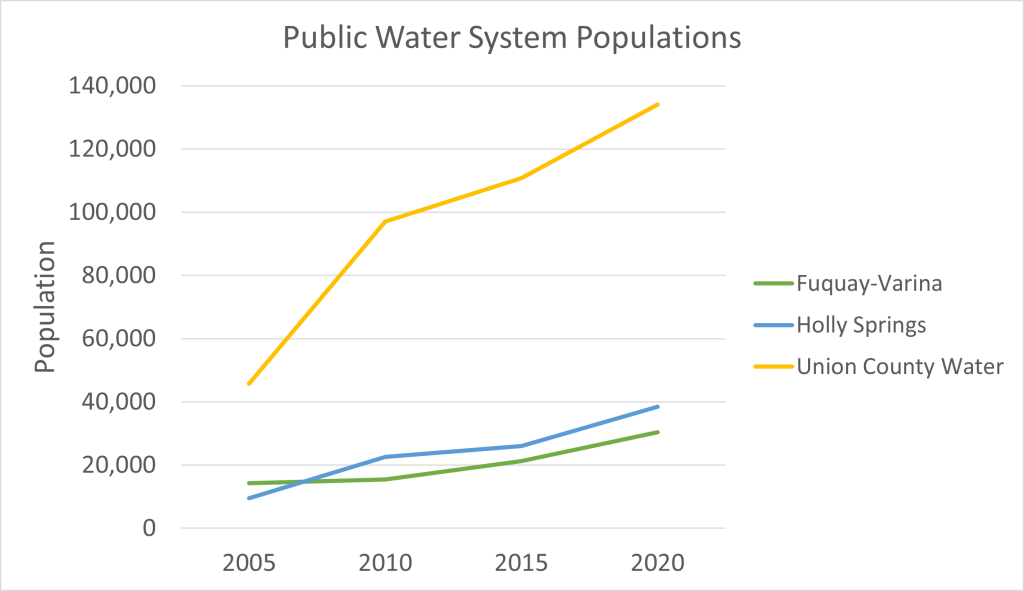Post by Julia Cavalier, Research Director at the UNC EFC, and Gabriela Santana, Graduate Research Assistant at the UNC EFC
This is the second blog in a two-part series presenting takeaways from North Carolina’s Viable Utilities Program. This post examines the problem small systems all wish they had – growth! The first post describes key findings relevant to other states on small system viability.
In May of 2022, the Environmental Finance Center at the University of North Carolina at Chapel Hill (UNC EFC) presented the results of interviews with state staff and utilities across North Carolina in support of the state’s Viable Utility Reserve Program. These interviews described challenges faced by many small utilities across the state. Here we present the “good problem to have” — growth. Growth is generally considered to be positive. With growth comes an increased customer base which leads to more potential revenue. There is also a public health benefit to extending water and sewer lines in previously underserved areas. Managing water and sewer centrally improves the quality and consistency of service to customers and lets the utility spread costs over a larger customer base.
Growth, however, isn’t always easy. The UNC EFC reviewed the fastest-growing utilities in North Carolina and discussed some of their challenges in interviews. The North Carolina Public Water Supply Section provided public drinking water populations for the City of Charlotte, Union County Utilities, and five municipalities in Wake County.
We compared utilities in Charlotte, North Carolina, and Union County, North Carolina to see how their patterns of growth differed. Charlotte is the largest city in North Carolina and runs the largest water utility in the state. State staff described Charlotte Water’s efforts to expand lines to previously underserved areas. At a state conference, Charlotte Water staff also described the challenges of keeping up with a large and growing capital improvement plan. Union County is a fast-growing and formerly rural area near Charlotte that is extending lines into previously underserved areas while also building a water treatment plant and transmission mains. Interviewees noted that extending service in long directions requires upsizing lines with increased capital and continuing operation and maintenance costs.
Wake County is the most populated county and one of the fastest-growing counties in the state. This is evident when reviewing population trends at the municipal level within the county. The populations of Raleigh and Cary almost doubled between 2005 and 2020, while the most recent and dramatic growth in the county has occurred in the towns of Holly Springs and Fuquay-Varina.
The chart below zooms in on the utilities that started small and saw dramatic growth. Union County Water’s population almost tripled between 2005 and 2020, and Holly Springs’ population more than tripled during the same time period. In the short period of 2015 – 2020, Holly Springs and Fuquay-Varina’s populations grew by over 40%. As state staff noted in their interviews, a 30% increase in connections can lead to hundreds of millions of capital spending. Rapidly growing areas like those highlighted here have had to fund such large capital projects and are planning for more.
Costs aren’t limited to capital expenses. Distributed systems also present challenges for water quality, as it’s difficult to maintain water quality for a large water system the farther you are from the treatment plants. In 90-degree summer temperatures, it is especially difficult to control disinfection byproducts! Some interviewees also said that distributed systems are more complex and difficult to manage than dense water systems. It can also take longer for utilities to read meters in distributed systems than in dense water systems, requiring more staff time for meter reading. While advanced treatment may help utilities control disinfection byproducts and remote meter reading may reduce staff time required to read customer meters, those solutions cost money to install. In addition to capital costs for installation, the solutions must also be maintained over time and eventually replaced. Maintenance and depreciation will be incorporated into the utility’s budget over the long term.
Growth brings opportunity and it also brings challenges. Many of the challenges that come with growth are financial. The UNC EFC is currently in the process of updating the Plan-to-Pay tool to help utilities understand and plan for the ongoing costs of expansion. Stay tuned for a future blog post highlighting that tool!
Need technical assistance? UNC Environmental Finance Center is here to help!
The Environmental Finance Center at UNC-CH offers free one-on-one technical assistance for small water systems. If you have an interest in our support, fill out our interest form here or contact mullins@sog.unc.edu.
Visit https://efc.sog.unc.edu/technical-assistance/ to read more about technical assistance.




2 Responses to “Challenges of Growth for Water Utilities”
Jim Roberts
Wonderful information. Can you help me find the first article referred to in the opening statement please.
imimani
The article referenced is this one: https://efc.sog.unc.edu/what-makes-small-utilities-viable/. Hope this helps!
Best,
Imani Russell, Research Assistant